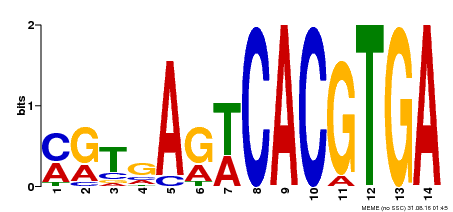 |
PlantRegMap/PlantTFDB v5.0
Plant Transcription
Factor Database
|
| Home TFext BLAST Prediction Download Help About Links PlantRegMap |
Transcription Factor Information
| Basic Information? help Back to Top | |||||||||
|---|---|---|---|---|---|---|---|---|---|
| TF ID | Csa11g025120.1 | ||||||||
| Organism | |||||||||
| Taxonomic ID | |||||||||
| Taxonomic Lineage |
cellular organisms; Eukaryota; Viridiplantae; Streptophyta; Streptophytina; Embryophyta; Tracheophyta; Euphyllophyta; Spermatophyta; Magnoliophyta; Mesangiospermae; eudicotyledons; Gunneridae; Pentapetalae; rosids; malvids; Brassicales; Brassicaceae; Camelineae; Camelina
|
||||||||
| Family | bHLH | ||||||||
| Protein Properties | Length: 212aa MW: 24541.3 Da PI: 5.2625 | ||||||||
| Description | bHLH family protein | ||||||||
| Gene Model |
|
||||||||
| Signature Domain? help Back to Top | |||||||
|---|---|---|---|---|---|---|---|
| No. | Domain | Score | E-value | Start | End | HMM Start | HMM End |
| 1 | HLH | 33.6 | 7.2e-11 | 36 | 79 | 7 | 55 |
HHHHHHHHHHHHHHHHHHCTSCCC...TTS-STCHHHHHHHHHHHHHHH CS
HLH 7 erErrRRdriNsafeeLrellPkaskapskKlsKaeiLekAveYIksLq 55
e+ErrRR+++ ++ Lr+++P + ++Ka+i+e A+ YI +Lq
Csa11g025120.1 36 EAERRRRQKLHVRLMALRSHVPIV-----TNMTKASIVEDAITYIGELQ 79
79*********************8.....69***************998 PP
| |||||||
| Protein Features ? help Back to Top | ||||||
|---|---|---|---|---|---|---|
| Database | Entry ID | E-value | Start | End | InterPro ID | Description |
| SuperFamily | SSF47459 | 8.64E-15 | 26 | 95 | IPR011598 | Myc-type, basic helix-loop-helix (bHLH) domain |
| CDD | cd00083 | 1.47E-10 | 27 | 83 | No hit | No description |
| Gene3D | G3DSA:4.10.280.10 | 2.0E-12 | 28 | 94 | IPR011598 | Myc-type, basic helix-loop-helix (bHLH) domain |
| PROSITE profile | PS50888 | 14.113 | 29 | 78 | IPR011598 | Myc-type, basic helix-loop-helix (bHLH) domain |
| SMART | SM00353 | 3.4E-12 | 35 | 84 | IPR011598 | Myc-type, basic helix-loop-helix (bHLH) domain |
| Pfam | PF00010 | 2.0E-8 | 36 | 79 | IPR011598 | Myc-type, basic helix-loop-helix (bHLH) domain |
| Gene Ontology ? help Back to Top | ||||||
|---|---|---|---|---|---|---|
| GO Term | GO Category | GO Description | ||||
| GO:0006355 | Biological Process | regulation of transcription, DNA-templated | ||||
| GO:0048658 | Biological Process | anther wall tapetum development | ||||
| GO:0005634 | Cellular Component | nucleus | ||||
| GO:0003700 | Molecular Function | transcription factor activity, sequence-specific DNA binding | ||||
| GO:0043565 | Molecular Function | sequence-specific DNA binding | ||||
| GO:0046983 | Molecular Function | protein dimerization activity | ||||
| Sequence ? help Back to Top |
|---|
| Protein Sequence Length: 212 aa Download sequence Send to blast |
MGGGSIFQEP VRMNRRRQVT EENKEEDESF KSPNLEAERR RRQKLHVRLM ALRSHVPIVT 60 NMTKASIVED AITYIGELQK NVQNLSEKLF EMEEAPPEID DVEQTDQTMI KPKLETIHLK 120 EEMKKLGIEE NVQLCKIGER RFWLKIITEK KAGIFTKYME VMRFLGFEII DISLTTSSGT 180 ILISSSVQIH EELCDVEQTK DFLLEVMRSN P* |
| Functional Description ? help Back to Top | ||||||
|---|---|---|---|---|---|---|
| Source | Description | |||||
| UniProt | Transcription factor. Involved in the control of tapetum development. Required for male fertility and pollen differentiation, especially during callose deposition. {ECO:0000269|PubMed:16831835}. | |||||
| Binding Motif ? help Back to Top | |||
|---|---|---|---|
| Motif ID | Method | Source | Motif file |
| MP00091 | SELEX | Transfer from AT4G21330 | Download |

| |||
| Cis-element ? help Back to Top | |
|---|---|
| Source | Link |
| PlantRegMap | Csa11g025120.1 |
| Regulation -- PlantRegMap ? help Back to Top | ||||||
|---|---|---|---|---|---|---|
| Source | Upstream Regulator | Target Gene | ||||
| PlantRegMap | Retrieve | Retrieve | ||||
| Annotation -- Nucleotide ? help Back to Top | ||||||
|---|---|---|---|---|---|---|
| Source | Hit ID | E-value | Description | |||
| GenBank | HQ379631 | 5e-90 | HQ379631.1 Arabidopsis lyrata haplotype Aly-S50 S-locus region genomic sequence. | |||
| GenBank | KJ772401 | 5e-90 | KJ772401.1 Arabidopsis lyrata haplotype S1 clone 29O9 S-locus region genomic sequence. | |||
| GenBank | KJ772414 | 5e-90 | KJ772414.1 Arabidopsis lyrata haplotype S18 clone 04A13 S-locus region genomic sequence. | |||
| Annotation -- Protein ? help Back to Top | |||||||
|---|---|---|---|---|---|---|---|
| Source | Hit ID | E-value | Description | ||||
| Refseq | XP_010439491.1 | 1e-154 | PREDICTED: transcription factor DYT1-like | ||||
| Swissprot | O81900 | 1e-121 | DYT1_ARATH; Transcription factor DYT1 | ||||
| TrEMBL | A0A330PHW2 | 1e-132 | A0A330PHW2_9BRAS; At421330-like protein | ||||
| STRING | XP_010439491.1 | 1e-153 | (Camelina sativa) | ||||
| Orthologous Group ? help Back to Top | |||
|---|---|---|---|
| Lineage | Orthologous Group ID | Taxa Number | Gene Number |
| Malvids | OGEM8358 | 25 | 38 |
| Best hit in Arabidopsis thaliana ? help Back to Top | ||||||
|---|---|---|---|---|---|---|
| Hit ID | E-value | Description | ||||
| AT4G21330.1 | 1e-109 | bHLH family protein | ||||



